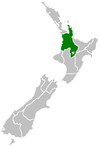| Ngatamariki Power Station | |
|---|---|
 | |
| Country | New Zealand |
| Location | 17 km (11 mi) northeast of Taupō, Waikato |
| Coordinates | 38°32′50″S 176°11′45″E / 38.54722°S 176.19583°E |
| Status | Operational |
| Construction began | July 2011 |
| Commission date | September 2013 |
| Construction cost | NZ$475 million [1] |
| Owner(s) | Mercury Energy |
| Geothermal power station | |
| Wells | 7 |
| Power generation | |
| Nameplate capacity | 82 MW 110 MW (Planned) |
| Annual net output | 700 GWh |
Ngatamariki is a geothermal power station commissioned in 2013 and operated by Mercury Energy. It is located approximately 17 km north east of Taupō and was constructed well under the budget of $475 million.[1][2][3]
The field was initially explored by the Crown in 1985-86, with the wells NM1, NM2, NM3, and NM4 drilled to 1300m, 2403m, 2194m, and 2749m respectively.[4] NM4 was the first well in New Zealand to encounter a pluton, at a depth of almost 2400m. Mighty River Power undertook further drilling in 2008-09, with wells NM5, NM6, and NM7 drilled to depths of 2997m, 3398m, 2963m respectively.[5] Resource consents for further development were granted in May 2010.[6]
Work at the geothermal field site on the first stage of the plant (82 MW) commenced in July 2011[7] and the plant became operational in September, 2013, one month later than scheduled.[2][8] The power station is a binary plant, supplied under an EPC contract by Ormat.[9] A 220,000-volt power line connects Ngatamariki to Mercury's Nga Awa Purua Power Station, where electricity from both stations is injected into Transpower's national grid.
The Ngatamariki Geothermal site consists of 7 geothermal wells (3 production and 4 re-injection). In addition to the main geothermal wells, there are 21 sentinel and monitoring wells, to depths of 1,500m.[1]

See also
[edit]References
[edit]- ^ a b c "New Ngatamariki Station boosts Mighty River Power's geothermal production, driving earnings growth" (Press release). Mighty River Power. 2 September 2013. Archived from the original on 5 October 2013.
- ^ a b "Mighty River Power Development Projects Update" (Press release). Mighty River Power. 13 June 2012. Archived from the original on 29 July 2012.
- ^ "New power station adds to grid capacity" (Press release). Mighty River Power. 18 January 2010.
- ^ Urzúa-Monsalve, Luis Alejandro (2008). Integration of a preliminary one-dimensional MT analysis with geology and geochemistry in a conceptual model of the Ngatamariki geothermal field (M.Sc.). University of Auckland.
- ^ O'Brien, Jeremy Mark (2010). Hydrogeochemical Characteristics of the Ngatamariki Geothermal Field and a Comparison with the Orakei Korako Thermal Area, Taupo Volcanic Zone, New Zealand (M.Sc.). University of Canterbury.
- ^ "Go ahead for geothermal plant at Tahorakuri". 13 May 2010.
- ^ "Mighty River Power to build new $466m geothermal plant". NZ Herald. 8 June 2011.
- ^ "Ngatamariki end of the power line". Fairfax NZ News. 3 September 2013.
- ^ "Mighty River Power To Build 82 MW Ngatamariki Project". ThinkGeoenergy. 7 June 2011.
External links
[edit]- "Ngatamariki Geothermal Power Station". Mighty River Power. Archived from the original on 2010-05-23.

Well, that’s interesting to know that Psilotum nudum are known as whisk ferns. Psilotum nudum is the commoner species of the two. While the P. flaccidum is a rare species and is found in the tropical islands. Both the species are usually epiphytic in habit and grow upon tree ferns. These species may also be terrestrial and grow in humus or in the crevices of the rocks.
View the detailed Guide of Psilotum nudum: Detailed Study Of Psilotum Nudum (Whisk Fern), Classification, Anatomy, Reproduction